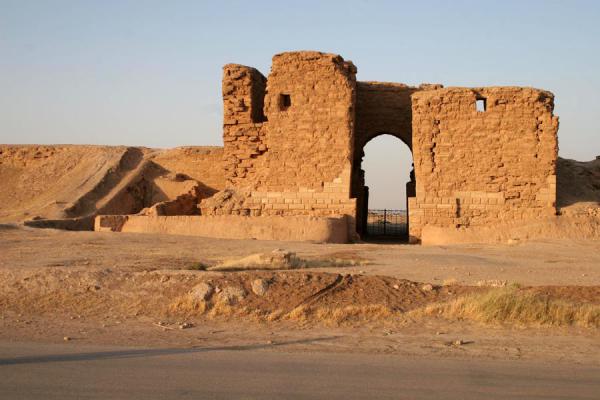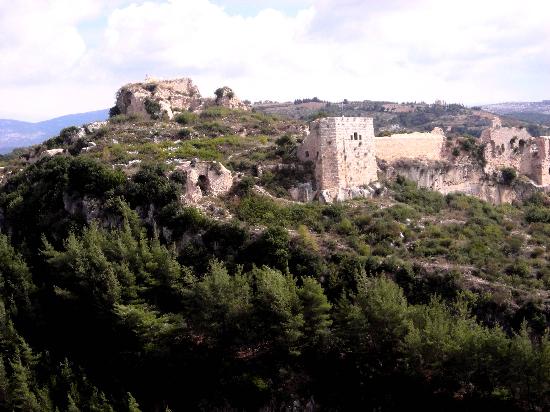Revisiting Aleppo with its Citadel, Souk and old Armenian Quarter was one of the many attractions which tempted me to book this tour to revisit the 'best' bits of Syria
On the trading routes with Europe, the Middle East and Asia, Aleppo has grown and flourished since the third millennium BC. Following its Greco-Roman plan, the vaulted bazaar winds through an amazing 15km of passages with beautiful adjacent caravanserai or khans. A particularly fine example is the Khan al-Wazir whose archway is formed of elegant traditional black and white alternate bands of stone.
This morning most of the group drove to the monastery of St Simeon, where a strange mystic and holy man spent 42 years of his life preaching from the top of a column, advising emperors and commoners to mend their ways. After his death, a beautiful church was built around the sacred column. However, we had spent a long time there on my previous visit and I decided to spend more time exploring the town.
After wandering around the new town for a while in search of one of the town's scarce ATMs, I headed into the souk to wander aimlessly through some of the small alleyways - with no real objective, it was good just the saunter through the routine daily life of the locals as the purchased their needs.

 Meeting up with the others on their return from the monastery, we had the opportunity to explore the mighty Citadel, whose awesome walls dominate the highest point of the city and resisted many fierce attacks. Surrounding the citadel is a moat and a steep bank of stones around the base, prevent the enemy from sustaining any direct hold on the bottom of the walls designed to 40 rectangular towers crown the battlements. Inside is a mix of a low ruins and a few complete buildings - probably the most impressive was the palace in which there was a large reception room that had been restored to show part of its former glory. It was a large space but with only a few pillars obstructing eye lines, the ceiling and walls were richly decorated with wood panelling and large glass lanterns dropped from the ceiling. The lights in the lanterns were switched on especially for us and their soft glow, together with sun light through the small stained glass windows, gave an impression of what it must have been in its prime.
Meeting up with the others on their return from the monastery, we had the opportunity to explore the mighty Citadel, whose awesome walls dominate the highest point of the city and resisted many fierce attacks. Surrounding the citadel is a moat and a steep bank of stones around the base, prevent the enemy from sustaining any direct hold on the bottom of the walls designed to 40 rectangular towers crown the battlements. Inside is a mix of a low ruins and a few complete buildings - probably the most impressive was the palace in which there was a large reception room that had been restored to show part of its former glory. It was a large space but with only a few pillars obstructing eye lines, the ceiling and walls were richly decorated with wood panelling and large glass lanterns dropped from the ceiling. The lights in the lanterns were switched on especially for us and their soft glow, together with sun light through the small stained glass windows, gave an impression of what it must have been in its prime.
We were told the story of the Aleppo Trojan sheep - when the Citadel was taken by men donning sheep skins to disguise themselves as animals as they climbed the glacis slope - chewing stale bread as a convincer as sheep are always chewing the cud - before scaling the wall and opening the gates. During our visit there were hundreds of schools kids there who used us as an ideal opportunity to practice their development English. When some said Salaam Alike to a little boy he was stunned into silence and rushed off to the teacher and it was clear from what he said to her, even if it was in Arabic, that he was gabbed-smacked that one of the strange foreigners had said 'Hello' to him in his own language.
On leaving the Citadel, the more primeval urge for food took over and we started the search for food. We found a small shop that sold what had become our staple lunch over past days. A fresh flat / pita bread wrapped around a filling of your choice - the common dominators were a small amount of salad & pickle, a sauce/gravy and the filling of your choice - vegetarian or carnivore : mine was chicken straight off the rotating kebab. These kebabs are similar to the ones in the UK seen in all chippies but differ in that they don't hang around for days and are totally consumed within a couple of days. To get served you elbowed your way into the shop's packed throng, ordered your choice from the cashier, who gave you your order written slip on a small slip of paper - the major task was then to squirm further into the crowd to the counter where your exchanged the paper for freshly prepared delicious food. Like fish & chips, it tastes best eaten directly from the paper on the street.
One of many tourist places of pilgrimage in Aleppo is Barons Hotel - in its time it was one of the city's prime hotels and accommodated such names as T E Lawrence and Agatha Christie. Its walls are still adorned with posters proclaiming the virtues of the train journey from Europe on the Orient Express and Taurus Express, new piston engine KLM aircraft and BOAC's fledging intercontinental routes. It is has now suffered from the ravages of time and you really have to exercise your imagination to see its former glory. We were taken on an unofficial tour by the porter to see Lawrence's room (twin beds, large bathroom and imposing heavy furniture) but were unable to see Ms Christie's room as it was occupied. In the high ceilinged room with damp stained walls, we sat in well used deep armchairs drinking Turkish beer (they had no other) and watched a parade of other tourists come in to pay homage. So came for a quick look at Lawrence's unpaid bill (framed in a small bookcase with a few other bits of memorabilia), others sat with us to absorb what had been.
Dinner was a less stressful affair tonight in another restaurant close to the hotel - good food with live music in the background. One of our number, a musician, was enthralled by the lute music and then almost when into a trance when he started to play the violin at our table.
Some went straight to bed but four of us went for a wander to give the food time to settle and to do some shopping: two get food for tomorrow's picnic (I was happy to pay for the one provided by the local guide) and another for money - or to be exact, an ATM. All was going well until we saw a clothing shop whose goods were spilling on to the pavement. On a detached pair of legs was a set of indescribable leggings. They were made of some sort of furry nylon and came in a range of garish colours in horizontal stripes. Somewhere vaguely Tigerish and another was remisent of Dennis the Menace -others were beyond description. I've tried a number of approaches to obtain a photo of these being modelled by those who made the purchases but, in either modesty or embarrassment, I have been rebuffed.





















